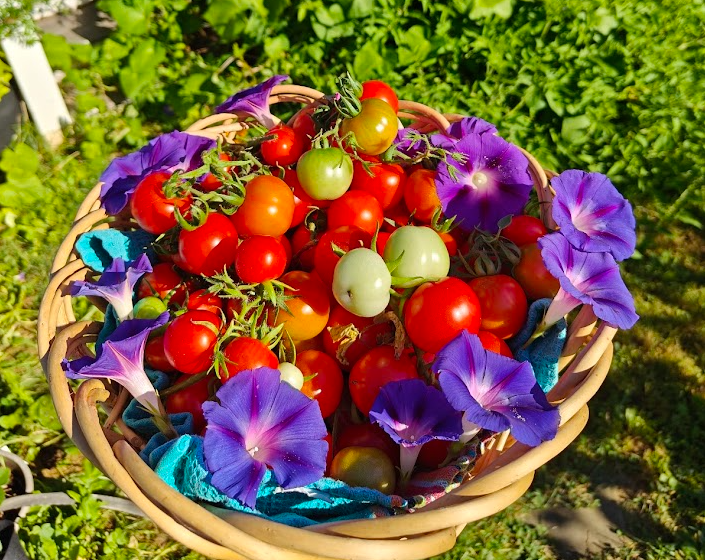I didn’t plan the moment; it just happened. Two little sets of feet twirled out the door ahead of me, hands already reaching for the harvest basket. Tomatoes blushed under the vines. Morning glories framed the path like a doorway we walk through together. It wasn’t a production—no voiceover, no soundtrack—just the soft rhythm of snips, laughter, and plants we’ve tended side by side.
That’s when it clicked again: this space isn’t just a garden. It’s a family room that happens to live outside.
The quiet ways a garden becomes a home
We don’t narrate much; we show up. Most days it’s the small things: a child watering without being asked; a first strawberry picked with two hands; a single red tomato that somehow tastes like a celebration. We’ve had tiny bowls of berries, two-blackberry harvests, a first-ever spaghetti squash that was comically small—and all of it mattered because we did it together.
We make space, and the garden answers. I’ve cleared unruly corners, chopped back tomato jungles, and reset beds for the next season. The work is sometimes messy and never perfect. But the quiet resets—pulling one cabbage to direct-sow summer seed, or mowing down the pumpkin patch to plant peas as cover crops—make room for what’s coming. Even the “waste” returns as nourishment.
We honor the surprises. A volunteer squash climbing an arch. A double male squash flower that won’t fruit but still feels like a gift. An overgrown, gate-wedged cucumber I somehow missed despite “checking every day.” The patch hides things from us and then reveals them like a game of peekaboo.
We share the load. One child waters, another picks, a third asks the questions during hand-pollination. We harvest bowls of tomatoes and carry them like treasures. We celebrate small wins—first cabbage after years of trying, first blackberry, first tiny spaghetti squash—because small wins shape family culture.
What makes a family garden different
1) We grow people while we grow food.
I hand-pollinate squash and a little voice narrates in the background. I tie up tomatoes on the deck steps while helpful chaos unfolds around me. The yield isn’t just cucumbers or collards; it’s patience, curiosity, and shared memory. The crop is character.
2) Our rhythms teach more than our rules.
Kids don’t follow lectures; they follow patterns. They copy the way we tuck in transplants, how we stake tomatoes, how we pick gently. Most of parenting is a pattern lived in front of them. “Teach them young” became less of a slogan and more of a weekday habit.
3) We let the seasons overlap.
Summer crops get tucked between fading spring beds. We pull a cabbage—not all of them—to make space for something new. We mow a pumpkin patch and plant peas that will later feed potatoes. Garden time refuses “all-or-nothing”; it honors “what’s ready now.”
4) We accept loss without losing heart.
Bugs and a friendly groundhog turned kale into lace. Aphids threw a party while we were away. Some squash never pollinated. We snip, compost, reset. Even the losses feed the next thing.
5) We celebrate the ordinary.
Two jalapeños and two blackberries, grown by small hands, shared like a feast. A single strawberry picked in slow motion. The “biggest zucchini yet” saved for the last shot of a reel. Ordinary moments become family lore.
Practical: how we make it feel like family (not stress)
1) One corner at a time.
Pick a single bed or a single task: “Clean, harvest, support.” Progress is a mood, not a metric.
2) Invite, don’t assign.
“Want to carry the basket?” turns helpers into owners. They twirl out the door because they feel it’s theirs, too.
3) Build rituals, not rules.
“Garden-to-table lunch” requires no recipe. Bowl + backyard + a fork. The ritual carries the weight.
4) Narrate the why.
“Tomatoes get tied up so they don’t topple,” “We compost so the waste feeds the next thing,” “We plant cover crops to help spring potatoes.” Reasons anchor rhythms.
5) Turn setbacks into stories.
“Who snacked on my kale?” is a laugh-and-learn moment. “Found a yellow cucumber wedged in the gate” becomes a family legend and a future checklist.
6) Keep the harvest human.
Freeze red tomatoes for winter, ripen green ones in baskets, and accept that some meals start with a walk instead of a plan. It’s okay to be “small-batch” on purpose.
If a garden can feel like family, a family can feel like a garden
I used to chase the moment everything matured at once—business fully scaled, kids perfectly behaved, garden overflowing for the big reveal. Now I love the layered reality: parenting like interplanting; business like staking; marriage like mulching around tender roots; and faith like the quiet confidence that even the garden’s letting-go seasons are part of its circle.
We don’t need every bed to be perfect. We need enough space to keep going.
We don’t need every plant to fruit. We need to keep sowing.
We don’t need a viral harvest. We need a family rhythm.
That’s what I’m building here: not a show, but a home; not perfection, but presence; not trends, but a rooted life. One cabbage, one child, one corner at a time.


Leave a Reply